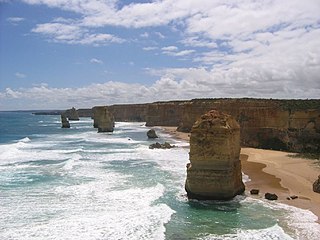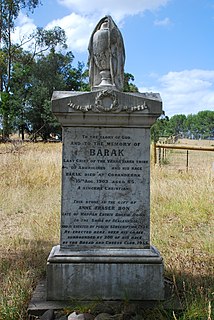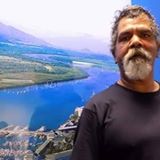
Arnhem Land is one of the five regions of the Northern Territory of Australia. It is located in the north-eastern corner of the territory and is around 500 km (310 mi) from the territory capital Darwin. The region has an area of 97,000 km2 (37,000 sq mi), which also covers the area of Kakadu National Park, and a population of 16,230. In 1623, Dutch East India Company captain William van Colster sailed into the Gulf of Carpentaria and Cape Arnhem is named after his ship, the Arnhem, which itself was named after the city of Arnhem in the Netherlands.

The Western District comprises western regions of the Australian state of Victoria. It is said to be an ill–defined district, sometimes incorrectly referred to as an economic region,. The district is located within parts of the Barwon South West and the Grampians regions; extending from the south-west corner of the state to Ballarat in the east and as far north as Ararat. The district is bounded by the Wimmera district in the north, by the Goldfields district in the east, by Bass Strait and the Southern Ocean in the south, and by the South Australian border in the west. The district is well known for the production of wool. The most populated city in the Western District is the Ballarat region, with 96,940 inhabitants.
NAIDOC Week is an Australian observance lasting from the first Sunday in July until the following Sunday.
The history wars in Australia are an ongoing public debate over the interpretation of the history of the British colonisation of Australia and development of contemporary Australian society.

Aboriginal Australian is a collective term for all the indigenous peoples from the Australian mainland and Tasmania. This group contains many separate cultures that have developed in the various environments of Australia for more than 50,000 years. These peoples have a broadly shared, though complex, genetic history, but it is only in the last two hundred years that they have been defined and started to self identify as a single group. The exact definition of the term Aboriginal Australian has changed over time and place, with the importance of family lineage, self identification and community acceptance all being of varying importance. In the past Aboriginal Australians also lived over large sections of the continental shelf and were isolated on many of the smaller offshore islands, once the land was inundated at the start of the inter-glacial. However, they are distinct from the Torres Strait Islander people, despite extensive cultural exchange.
Wathaurong, also called the Wathaurung and Wadawurrung, are an Indigenous Australian tribe living in the area near Melbourne, Geelong and the Bellarine Peninsula. They are part of the Kulin alliance. The Wathaurung language was spoken by 25 clans south of the Werribee River and the Bellarine Peninsula to Streatham. They were sometimes referred to by Europeans as the Barrabool people. The area they inhabit has been occupied for at least the last 25,000 years, with 140 archaeological sites having been found in the region, indicating significant activity over that period.

Coranderrk was a government reserve for Australian Aborigines in the state of Victoria between 1863 and 1924, located 50 km north-east of Melbourne.

Thomas Alexander Browne was an Australian author who published many of his works under the pseudonym Rolf Boldrewood. He is best known for his 1882 bushranging novel Robbery Under Arms.
The Dhauwurd Wurrung, also known as the Gunditjmara, are an Indigenous Australian people of southwestern Victoria. They are the traditional owners of the areas now encompassing Warrnambool, Port Fairy, Woolsthorpe and Portland.
Jeannie Gunn OBE was an Australian novelist, teacher and Returned and Services League of Australia (RSL) volunteer.
Indigenous Australians are the Aboriginal and Torres Strait Islander people of Australia, descended from groups that existed in Australia and surrounding islands before British colonisation. The time of arrival of the first Indigenous Australians is a matter of debate among researchers. The earliest conclusively human remains found in Australia are those of Mungo Man LM3 and Mungo Lady, which have been dated to around 50,000 years BP. Recent archaeological evidence from the analysis of charcoal and artefacts revealing human use suggests a date as early as 65,000 BP. Luminescence dating has suggested habitation in Arnhem Land as far back as 60,000 years BP. Genetic research has inferred a date of habitation as early as 80,000 years BP. Other estimates have ranged up to 100,000 years and 125,000 years BP.
Indigenous intellectual property is an umbrella legal term used in national and international forums to identify indigenous peoples' claims of intellectual property rights to protect specific cultural knowledge of their groups.

An Indigenous Protected Area is a class of protected area used in Australia formed by agreement with Indigenous Australians, declared by Indigenous Australians, and formally recognised by the Australian Government as being part of its National Reserve System.
The Convincing Ground Massacre was a skirmish between the indigenous Gunditjmara people Kilcarer gundidj clan and local whalers based in Portland, Victoria in South-Eastern Australia. Tensions between the two groups had been building since the establishment of the town as a whaling station some five years previously, however, around eighteen thirty three or eighteen thirty four, a dispute over a beached whale would cause events to escalate.

The Australian frontier wars is a term applied by some historians to violent conflicts between Indigenous Australians and white settlers during the British colonisation of Australia. The first fighting took place several months after the landing of the First Fleet in January 1788 and the last clashes occurred in the early 20th century, as late as 1934. An estimated 20,000 Indigenous Australians and between 2,000 and 2,500 settlers died in the wars. However, recent scholarship on the frontier wars in what is now the state of Queensland indicates that Indigenous fatalities may have been significantly higher. Indeed, while battles and massacres occurred in a number of locations across Australia, they were particularly bloody in Queensland, owing to its comparatively larger pre-contact Indigenous population.
Racism in Australia traces both historical and contemporary racist community attitudes, as well as political non-compliance and governmental negligence on United Nations human rights standard and incidents in Australia. Contemporary Australia is the product of multiple waves of immigration, predominantly from the United Kingdom and Ireland.
Ancestral domain or ancestral lands refers to the lands, territories and resources of indigenous peoples, particularly in the Asia-Pacific region. The term differs from indigenous land rights, Aboriginal title or Native Title by directly indicating relationship to land based on ancestry, while domain indicates relationships beyond material lands and territories, including spiritual and cultural aspects that may not be acknowledged in land titles and legal doctrine about trading ownership.

Vincent Mark Hilton Mundraby was a Far North Queensland Aboriginal Australian Yidinji rights activist.









